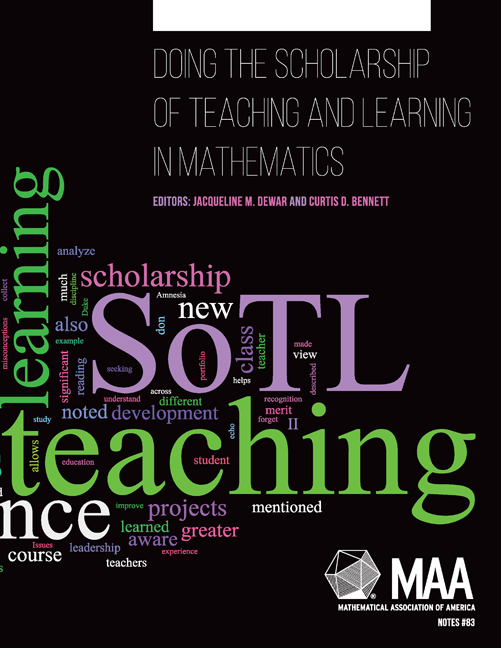Book contents
- Frontmatter
- Contents
- Foreword
- Preface
- Part I Getting Started in SoTL as a Mathematician
- 1 Understanding SoTL and Its Potential Benefits
- 2 Initiating a SoTL Investigation
- 3 Gathering and Analyzing Evidence
- 4 Resources for Pursuing SoTL and Going Pubilc
- Part II Illustrations of SoTL Work in Mathematics
- Epilogue
- Index
4 - Resources for Pursuing SoTL and Going Pubilc
from Part I - Getting Started in SoTL as a Mathematician
- Frontmatter
- Contents
- Foreword
- Preface
- Part I Getting Started in SoTL as a Mathematician
- 1 Understanding SoTL and Its Potential Benefits
- 2 Initiating a SoTL Investigation
- 3 Gathering and Analyzing Evidence
- 4 Resources for Pursuing SoTL and Going Pubilc
- Part II Illustrations of SoTL Work in Mathematics
- Epilogue
- Index
Summary
Introduction
This chapter, which closes Part I, offers additional resources and advice for completing a SoTL project. These include the need to obtain human subjects clearance in order to publish the results of the study, why it is a good idea to find collaborators for doing SoTL, and where to find them. Suggestions are offered for other sources of support and possible venues for dissemination. As in the previous chapters, the work of the authors in Part II provides examples.
Human Subjects Considerations
At the outset of a SoTL investigation, if the goal is to publish the results, then human subjects issues will arise, which will be unfamiliar to many mathematicians. According to United States Federal Guidelines, a human subject is a person about whom an investigator (whether professional or student) conducting research obtains data through intervention or interaction with the individual or identifiable private information (32 CFR 219.102.f). Because of past abuses of human subjects in medical trials in populations such as prisoners or minorities in the armed forces, the federal government has developed procedures requiring informed consent for human subjects research (U.S. Department of Health and Human Services, n.d.). Special rules for obtaining informed consent apply to any subject under the age of 18, a situation that can be encountered in SoTL studies of first-year college courses.
Because SoTL publications may involve making the work of our students public, we must follow institutional guidelines for working with human subjects. Most colleges and universities have a committee or group, often called an Institutional Review Board (IRB) or a Human Subjects Review Board, charged with ensuring that the federal guidelines are observed.
Human subjects researchers are expected to inform their subjects of the risks of their involvement in the study and obtain written consent for their participation. Studies that involve little or no physical or emotional risk to the subject, and will not reveal anything about the subject's behavior that would be damaging if it became public, may be exempted from obtaining written consent.
- Type
- Chapter
- Information
- Publisher: Mathematical Association of AmericaPrint publication year: 2014

